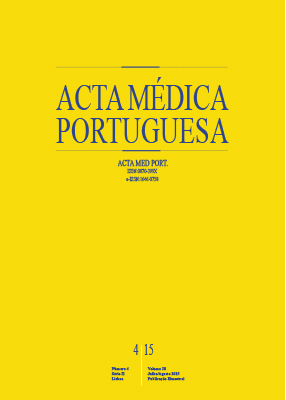Minimal Hepatic Encephalopathy: The Reality Beyond Our Eyes
DOI:
https://doi.org/10.20344/amp.6035Keywords:
Cirrose Hepática, Encefalopatia Hepática, Psicometria, Testes Neuropsicológicos.Abstract
Introduction: Minimal hepatic encephalopathy refers to a mild neurocognitive impairment not detectable by clinical examination that can be present in cirrhotic patients.
Aim: To determine the prevalence of minimal hepatic encephalopathy in a secondary healthcare center in Northern Portugal.
Material and Methods: A cross-sectional study was conducted. Cirrhotic outpatients were included. Exclusion criteria: overt hepatic encephalopathy, illiteracy, active alcohol consumption, psychotropic drug use and therapy with lactulose. The presence of minimal hepatic encephalopathy was defined as a value ≤ -4 on the Psychometric Hepatic Encephalopathy Score, calculated according to the Portuguese norms. Variables analyzed: etiology and severity of liver disease and venous blood ammonia concentration. p values <
0.05 were considered significant.
Results: From the 102 patients who were evaluated, 41 were included: 31 males, mean age 57 ± 10 years, mean education 5 ± 2 years, 31 in Child-Pugh class A, mean MELD score 6 ± 3. Minimal hepatic encephalopathy was diagnosed in 14 (34%) patients. The presence of minimal hepatic encephalopathy was unrelated to severity of liver disease. Despite being more elevated, the mean venous ammonia concentration in minimal hepatic encephalopathy patients was not statistically different from the mean venous ammonia concentration in non-minimal hepatic encephalopathy patients (48.5 ± 13.3 vs. 45.6 ± 15.6 μmol/L, p = 0.555).
Discussion: The prevalence of minimal hepatic encephalopathy reported is in accordance with the international published data.
Conclusion: Minimal hepatic encephalopathy is a frequent condition that is present early in the course of cirrhosis, even in compensated cirrhotic patients. Therefore, this hidden entity should be actively pursued and managed properly.
Downloads
Downloads
Published
How to Cite
Issue
Section
License
All the articles published in the AMP are open access and comply with the requirements of funding agencies or academic institutions. The AMP is governed by the terms of the Creative Commons ‘Attribution – Non-Commercial Use - (CC-BY-NC)’ license, regarding the use by third parties.
It is the author’s responsibility to obtain approval for the reproduction of figures, tables, etc. from other publications.
Upon acceptance of an article for publication, the authors will be asked to complete the ICMJE “Copyright Liability and Copyright Sharing Statement “(http://www.actamedicaportuguesa.com/info/AMP-NormasPublicacao.pdf) and the “Declaration of Potential Conflicts of Interest” (http:// www.icmje.org/conflicts-of-interest). An e-mail will be sent to the corresponding author to acknowledge receipt of the manuscript.
After publication, the authors are authorised to make their articles available in repositories of their institutions of origin, as long as they always mention where they were published and according to the Creative Commons license.









